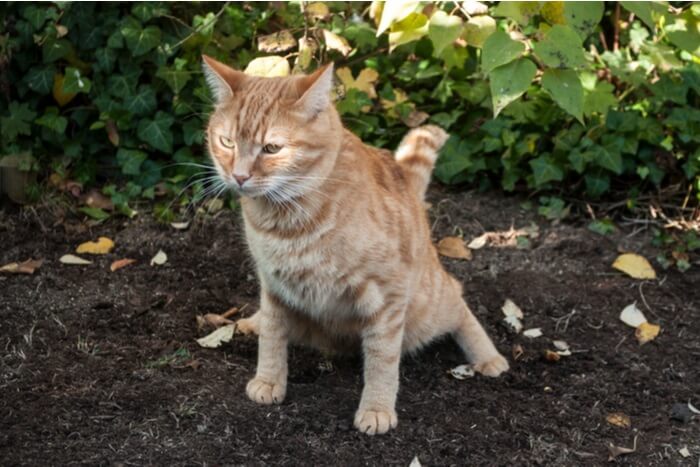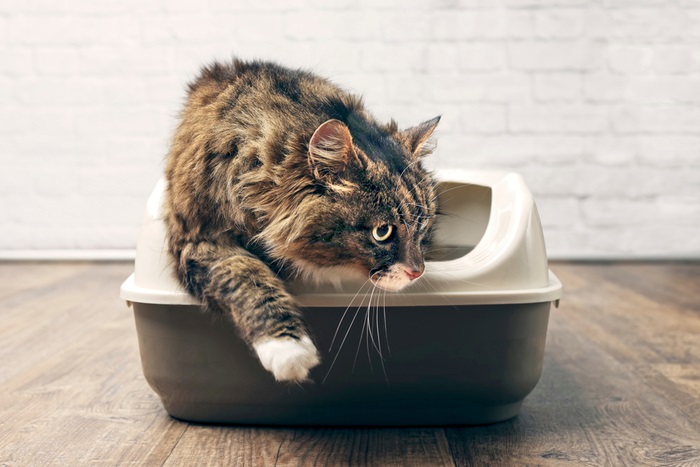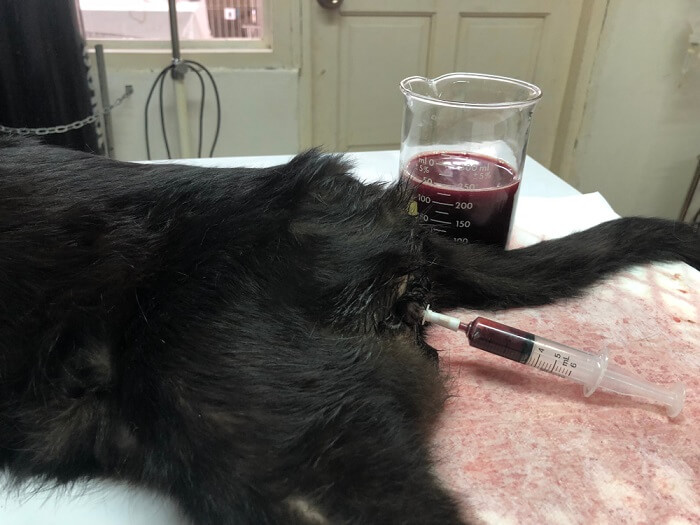
If your cat has started urinating blood (officially termed ‘haematuria’), it’s likely you’re worried. You should know what peeing blood can mean, how to treat urinary problems in cats, and when to contact the vet so that you can give your cat the best care.
Causes of Blood in Cat Urine
Your cat’s urinary system starts at the kidneys. Urine produced here moves through the ureters and is stored in the bladder until it is voided through the urethra and into the tray.
Things can go wrong with any part of this system to cause blood in your cat’s urine. The most common problems occur in the lower urinary tract (the bladder and urethra) and form a spectrum of diseases called ‘Feline Lower Urinary Tract Disease’ or ‘FLUTD’.
The Kidneys and Ureters
The kidneys and ureters are a rare cause of feline haematuria. Kidneys suffering from failure can bleed, especially when the cat also has high blood pressure. Cats can also suffer from kidney and ureter tumours. Compared to haematuria from the bladder or urethra, bleeding from the kidneys and ureters is rare.
The Bladder
Most possible causes of blood in your cat’s urine happen in the bladder and can include bladder tumours, bladder infections, and bladder stones. However, the most common cause of blood coming from the bladder is Feline Idiopathic Cystitis, or ‘FIC’.
Feline idiopathic cystitis can only truly be diagnosed when all the other causes of cystitis have been ruled out, but it’s often presumed in young and otherwise healthy cats because it’s so common.
We don’t yet fully know why it happens, but we do know some things- it appears to be linked to stress, and is more common in indoor, overweight, female cats on a dry diet. In FIC, the cells of the bladder wall are usually defective, having too little glycosaminoglycans to work properly. And stress causes nerves in the bladder to be stimulated to release neurotransmitters that increase inflammation.
Bladder infections do occur in cats, but much less commonly. Normal feline urine isn’t a good place for bacteria to thrive, so an infection often has an underlying cause such as diabetes or renal disease, where the urine is changed to the benefit of the bacteria.
Stones and crystals can also form in your cat’s bladder.
Whilst crystals pass without harm, stones can cause major irritation and inflammation, and pave the way for more serious infection. The cause of bladder stones is not fully understood, but a combination of dietary factors (such as diets with high mineral content), a sedentary lifestyle, obesity, and concentration of urine can lead to disease.
The Urethra

Blood in cat urine is most often caused by issues in the lower urinary tract (from the bladder to the urethra), but it may also stem from the kidneys and ureters.
The urethra is the tube that connects your cat’s bladder to the outside world, therefore anything that goes wrong with the bladder usually affects the urethra too.
The most common things to go wrong with the urethra are inflammation caused by FIC or by the movement of bladder stones or ‘uroliths’. Infections are also possible, but as with bladder infection, urethral infection is rare.
The urethra can also become blocked by a stone (and/or by a ‘plug’ of mucus in the male cat), which stops the flow of urine altogether. This is an emergency, and your cat will likely be very uncomfortable, straining, crying, and visiting the tray but producing nothing. A ‘blocked’ cat can become fatal within a few hours, so if you see these signs you should visit the nearest open vet as soon as possible.
What To Do if Your Cat Has Blood in Their Urine?
If you notice your cat has blood in their urine, it’s time to talk to your vet. If possible, you should get a sample of the urine to take for testing.
This can be done by using a special non-absorbent cat litter. Alternatively, if your cat has peed in the bath or on a tiled floor, you may be able to suck it up with a pipette or syringe. If you can’t get a sample, don’t worry- your vet may be able to get one for you.
Try to get an appointment within the next 24 hours, as many conditions causing blood in the urine of cats are painful.
Your vet will want to examine your cat and feel their bladder. If this is the first time your cat has had this problem, you and your vet will need to discuss whether to investigate further, or whether to trial treatment for FIC. Whether this is appropriate will depend on your cat’s age, gender, and other symptoms.
Further investigations are likely to involve urine tests, ultrasound exams, blood tests, and even x-rays.
Treatment for Urinary Tract Disease

Treating blood in your cat’s urine should address the underlying cause of the haematuria. For cats with a urethral blockage, treatment is urgent and involves catheterization.
The exact treatment your cat undergoes will depend on their symptoms and final diagnosis. For the most common cause- cystitis- there’s no specific treatment. Instead, symptoms are controlled using anti-inflammatories.
Herbal supplements are available that may help the bladder lining, but most of these have little clinical evidence to back their use. Since FIC is associated with stress, calming supplements may also be of use.
Of course, if your cat is suffering from another type of urinary tract disease, treatment might differ. Cats with infections, for instance, will need antibiotics, as well as treatment for the underlying cause. Cats with urinary stones may need a special diet to help reduce the crystals in the urine, and these stones may need to be removed surgically.
Cats with a blocked urethra will need ‘unblocking’ urgently- by passing a urinary catheter under general anaesthetic. And cats with bladder tumours may have chemotherapy or surgery as an option- although whether this is appropriate for your cat is a decision for you and the veterinary surgeon to make together.
In all cases, increasing your cat’s water intake is an important part of treatment. You can do this by switching your cat to wet food, by adding water to your cat’s dry food, and by encouraging drinking using a variety of bowls and fountains scattered throughout the house.
There is some new evidence that suggests that ‘water supplements’ may increase hydration in cats too- so that’s something to look out for in the future.
Also Read: How Much Water Should a Cat Drink?
Conclusion
Urinary tract disease is very common in cats. Whilst all parts of the urinary system can be affected, the most common cause of blood in the urine is idiopathic cystitis, or FIC. Cats with FIC are prone to recurrent attacks, and it can be painful. Knowing the signs, and knowing when to take your cat to the vet, is the key to fighting this painful condition.







